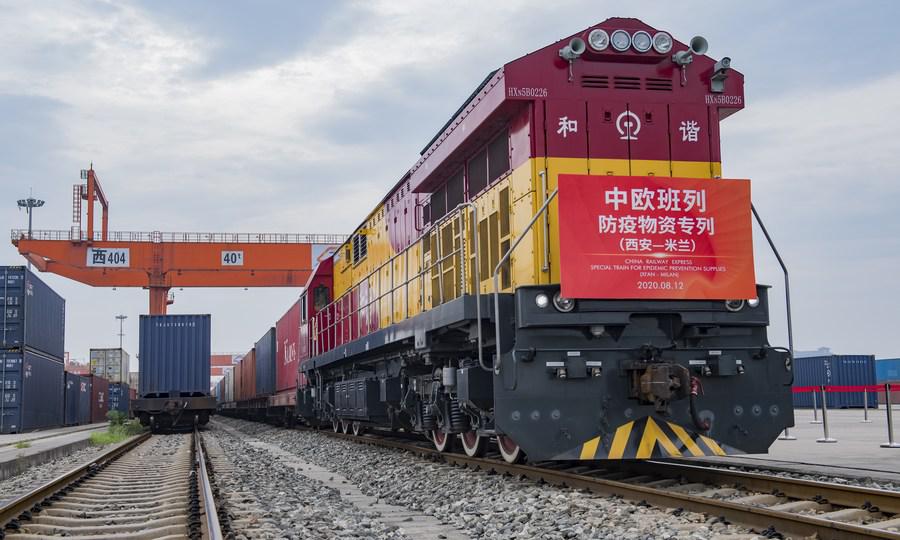Wuhan-Milan train link to boost trade ties between China, Italy

A China-Europe freight train with 45 compartments of anti-epidemic supplies leaves the Xinzhu Railway Station in Xi'an, northwest China's Shaanxi Province, Aug. 12, 2020, to head for Italy's Milan. (Photo by Yuan Jingzhi/Xinhua)
"Trade between China and Italy is already strengthening, and this will add a new option that will make the trade links faster and more efficient," Olivero Fiorini, an economist and trade analyst in Milan, told Xinhua.
ROME, April 20 (Xinhua) -- The newly opened freight-train link between Wuhan, China, and Milan, Italy will add a valuable new option to boost bilateral trade, analysts said.
According to data from TRA Consulting, the new link, launched last month, adds to an already fast-growing network of train links between China and Europe.
According to TRA Consulting, the year 2020 saw 12,406 train runs between China and Europe, up from 8,225 the year before and nearly double the 6,363 runs in 2018. But until last month, none of those trains were regularly scheduled direct freight links between China and Italy.
"Trade between China and Italy is already strengthening, and this will add a new option that will make the trade links faster and more efficient," Olivero Fiorini, an economist and trade analyst with ABS Securities in Milan, told Xinhua.
Even before plans for the Wuhan-Milan link were drawn up, the economic ties between China and Italy were strong. In 2019, Italy signed a Memorandum of Understanding with China on the Belt and Road Initiative (BRI). That year China was again one of Italy's top trading partners.

Pedestrians linger on Piazza del Duomo in Milan, Italy, Nov. 6, 2020.(Photo by Alberto Lingria/Xinhua)
According to the data firm Statista, 7 percent of Italy's imports came from China, trailing behind Germany and France. The World Factbook reported China was the ninth largest buyer of Italian products last year, accounting for 3 percent of the country's total exports.
TRA Consulting's data showed that a tiny percentage of the trade between China and its European partners was transported by train: just 2 percent of the total in 2017, compared to 6 percent by road, 28 percent by air, and 64 percent via sea routes.
But according to Andrea Giuricin, a professor of transport economics at Milan's Bicocca University and the chief executive of TRA Consulting, the popularity of rail transport is just beginning to grow.
"Trains are a midway point between expensive air transport that can have merchandise arrive in a day, and inexpensive cargo ships that take 30 or 35 days to deliver their goods between China and Italy," Giuricin told Xinhua.
According to Wuhan Asia-Europe Logistics Co., Ltd., the freight trains between Wuhan and Milan make the trip in 21 or 22 days. Transport costs, Giuricin said, were far below those of air transport but more expensive than cargo ships.
Giuricin said trains between China and Europe were still too slow to transport perishable goods. But the links were ideal for automobiles, car parts, and electronic goods. He predicted that the rail links between China and Italy and other European ports of call would see strong growth for at least the next six to seven years.

Aerial photo taken on April 19, 2017 shows the pilot free trade zone (FTZ) in Wuhan City, capital of central China's Hubei Province. (Xinhua/Xiong Qi)
Photos
Related Stories
- Freight train service prospers amid enhanced Sino-Italian trade ties
- China strongly condemns deadly attack on Italian ambassador in DRC
- China, Italy cities cooperate to protect World Heritage Sites
- Online celebrations held to mark 50th anniversary of China-Italy diplomatic ties
- Italy's organizations expect China's recovery to have "profound" effects on other economies
Copyright © 2021 People's Daily Online. All Rights Reserved.










